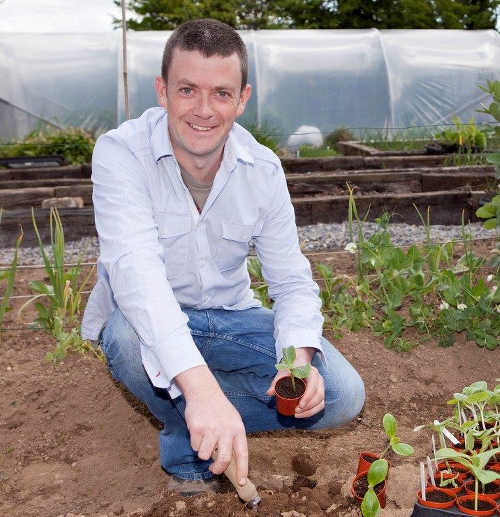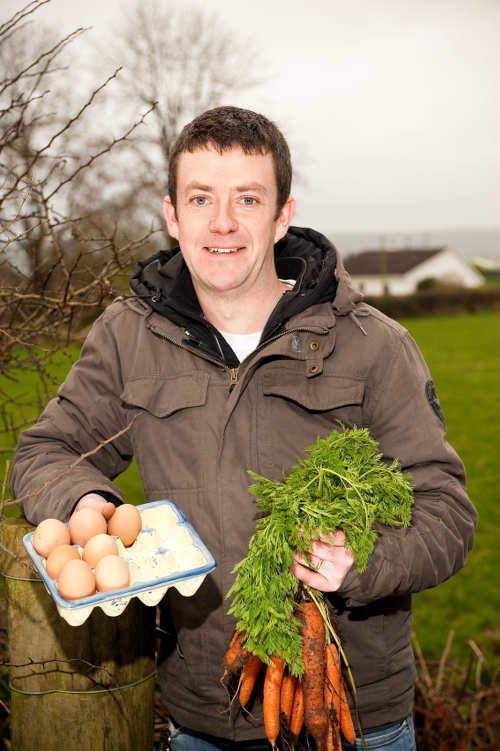Grow It Yourself - April
 A few months ago, I was giving a talk about growing things (as you do) to a GIY group and was discussing the growing of spuds when a woman put up her hand to comment. She told us about a tradition in her family when the first new spuds of the season were being harvested. Her grandmother would always take a small batch of new spuds and put them in a biscuit tin, throw in a small covering of soil, put a lid on top and then bury the tin in the garden. The tin would wait patiently in the soil for 6 months and then on Christmas Eve they would dig it up so that they could have “new spuds” for Christmas dinner. What a marvelous thing.
A few months ago, I was giving a talk about growing things (as you do) to a GIY group and was discussing the growing of spuds when a woman put up her hand to comment. She told us about a tradition in her family when the first new spuds of the season were being harvested. Her grandmother would always take a small batch of new spuds and put them in a biscuit tin, throw in a small covering of soil, put a lid on top and then bury the tin in the garden. The tin would wait patiently in the soil for 6 months and then on Christmas Eve they would dig it up so that they could have “new spuds” for Christmas dinner. What a marvelous thing.
I was struck that night, as I always am, by the irresistible sense of camaraderie in the room. The fact that you know everyone in the room is either currently growing food or interested in growing food means that you can strike up a conversation instantly with anyone.
That was the idea behind the creation of the first GIY group back in 2008 in Waterford, when a merry band of GIYers came together with the idea of helping each other to grow food. And that ethos continues to inform the expansion and evolution of the GIY group network. It is a belief that growing food is easier and more fun, if you come together with other people to do it.
The Waterford group was meant to be a one-off, but compelling ideas have their own momentum. Within a couple of months other people had taken the idea and adapted it to create a GIY group in their own community. A hallmark of the movement is that it is spontaneously evolving. There are groups of all shapes and sizes and types. The more people that get involved, the more the network changes. Ideas are shared, interesting things happen.
New types of GIY groups emerge – in work places, in homes, in community gardens. Groups are the beating heart of the GIY movement, and ‘local champions’ are the changemakers that make it all happen. If you’re willing to get your hands dirty and start a GIY group in your community, get in touch – we’d love to help.
By joining GIY you help us to continue the work of supporting people just like you to grow food at home, at school, in the workplace and in the community – each year we support over 50,000 people and 800 community food growing groups and projects.
It costs just €35 to join GIY for a year, and to say thanks we will send you a seasonal copy of our supporter’s magazine GROW and some GIY seeds for you to sow each quarter. We will also send you our weekly tips, news and advice ezine and offer you discounts to GIY events like the annual GROW Summit. Join today at www.giyireland.com
Things to do this Month - April
To Do
If poor weather in March has hampered your outdoor work, then April is the month to catch-up. The key words for April are weeds and slugs. You need to stay on top of them both. Check your early spuds regularly and ‘earth-up’ as required. Water your tunnel/greenhouse – things can get pretty warm on a nice sunny April day and seedlings will dry out quickly.
Sow
Indoors: lettuce, tomato, pepper, chilli-pepper, cucumber, celery, celeriac, basil, leeks, cabbage, cauliflower, Brussels sprouts, parsley, courgette, marrow, globe artichoke, beans, sweet corn and pumpkin. Outdoors: broad bean, onion sets, pea, beetroot, cabbage, spinach, Brussels sprouts, parsnip, spring onion, leek, carrot, radish, broccoli, turnip. Plant out cabbage plants when they are 15/20 cm tall into well prepared soil that has been manured.
Harvest
Stored fruit and vegetables are likely to be a distant memory at this stage and new crops are only starting to trickle in which makes April a tricky proposition. The middle of this month might see the first asparagus and the first early spring cabbage. The other two star performers this month are purple sprouting broccoli and rhubarb.
Recipe of the Month – Asparagus, Beetroot and Baby Spinach Salad
We often see the first asparagus of the year in April, but the beetroot for this salad are likely to be from stores (we keep a stash, picked the previous October, in the garage in a box of sand) as the first beetroot from the polytunnel won’t be ready until next month. I adapted this from a Tom Kime recipe and it serves 6 people.
Ingredients:
For the dressing
• a large handful of marjoram leaves
• 1 garlic clove
• juice of 1½ lemons
• 4 tbsp extra-virgin olive oil
For the salad
• 250g bunch asparagus, cut into 3cm lengths
• 3 medium beetroot (about 500g), cooked and cut into quarters
• zest of 1 lemon
• 2 spring onions, finely sliced
• A good selection of oriental greens such as mizuna, mibuna, red mustard
• About 20 spinach leaves
• 400g goat's cheese
Instructions
First make the dressing. Put the marjoram, a pinch of salt and the garlic into a food processor and pulse to a paste. Add the lemon juice and whizz until smooth. Stir in the olive oil and season – it should be sharp and a bit salty. Cover and chill.
Two hours before serving: bring a pan of salted water to the boil, add the asparagus and cook for 3 minutes. Drain and cool under the cold tap. Cover and keep cool. Put the beetroot in a large bowl and toss with twothirds of the dressing. Add the lemon zest and spring onions, cover and keep at cool room temperature with the remaining dressing.
To serve: add the oriental greens and spinach to the beetroot. Toss in the asparagus and season with freshly ground black pepper. Taste before adding salt as the cheese is quite salty. Mix lightly, so you don’t dye everything pink, then pile into a serving dish. Crumble over the cheese and pour the remaining dressing on top.
Tip of the Month – Sowing Onions
As long as the weather is not to harsh, April is the perfect month for sowing onions. Generally most GIYers grow onions from “sets” (basically baby onions) but you can also grow from seed. Sets will mature quickly. Sow sets 10cm apart in rows 25cm apart. Push the set in to the soil so that the tip is just about visible above the surface. Firm in well.
Just-sown onion sets are vulnerable to ‘frost heave’ which means that the expansion and contraction of soil as a result of warming and cooling can literally heave the little sets from the soil. If this happens push them back in the next day. In our garden the more likely problem is the occasional errant hen who (despite clipped wings) will hop over the picket fence in to the veg patch and start scratching in beds – newly sown beds are her favourite! Magpies and pigeons can also be an issue, pecking at the sets to pull them out. So, I cover the bed with fleece (with bricks placed on the corner to keep it tight and stop it blowing away), which gives some protection to the sets for a few weeks while they get established.
 About GIY
About GIY
GIY is a not-for-profit organisation that aims to create a healthier, more sustainable world where people grow their own food. We inspire and support people to grow food more successfully by bringing them together to share advice, tips and ideas. There are approximately 50,000 people involved in the GIY movement in Ireland, which is proudly supported by Woodies DIY.
For more information check out www.giyireland.com
Michael Kelly is a freelance journalist, author and founder of GIY Ireland.
© GIY Ireland 2015 – all rights reserved.






There are currently no comments
Leave a comment
Not a member? Register for your free membership now!
Or leave a comment by logging in with: